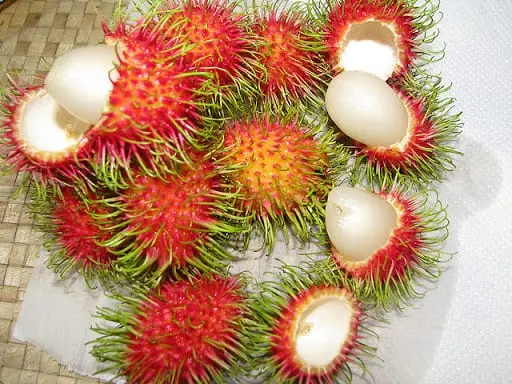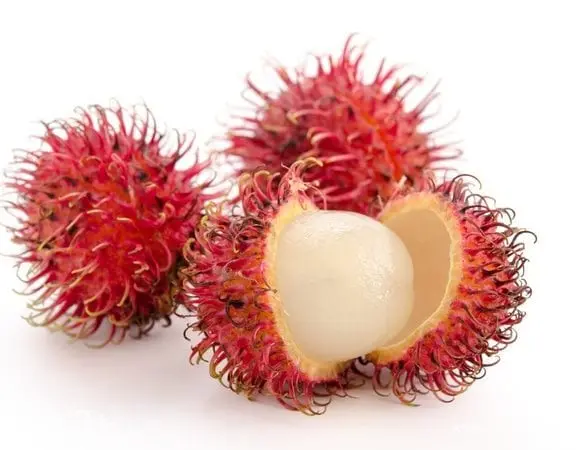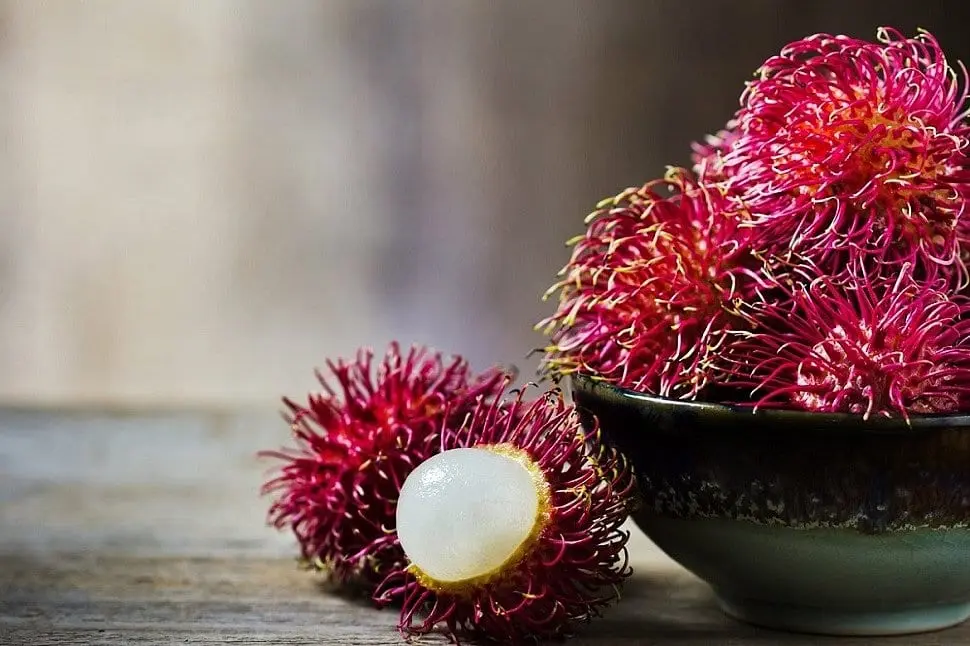Contents
Description
Rambutan (lat.Nephelium lappaceum) is a tropical fruit tree of the Sapindaceae family, native to Southeast Asia, cultivated in many countries of this region. The name of the plant is associated with the appearance of the fruit, in Indonesian rambut means “hair”.
An evergreen tree up to 25 meters high with a wide spreading crown. The leaves are paired, with 2-8 oval or ovoid leathery leaves.
In the meantime, there is no need to worry about it. ”
Full fruit ripening occurs 15-18 weeks after flowering.
Fruits are round or oval, 3-6 cm in size, grow in clusters of up to 30 pieces. As they ripen, they change color from green to yellow-orange, and then bright red. Covered with a dense, but easily separated from the flesh skin, covered with tough, crocheted hairs of dark or light brown color, up to 2 cm long.
Their flesh is gelatinous, white or slightly reddish, aromatic, with a pleasant sweet and sour taste. The seed is large, oval, up to 3 cm long, brownish in color.
Composition and calorie content
100 g of rambutan contains:
- Water – 78 g
- Proteins – 0.65 g
- Fat – 0.2 g
- Carbohydrates – 20 g
- Dietary fiber (fiber) – 0.9 g
- Ash – 0.2 g
- Vitamins:

- Vitamin A (beta-carotene) – 2 mcg
- Vitamin B1 (thiamine) – 0.013 mg
- Vitamin B2 (riboflavin) – 0.022 mg
- Niacin (vitamin B3 or vitamin PP) – 1.35 mg
- Vitamin B5 (pantothenic acid) – 0.018 mg
- Vitamin B6 (pyridoxine) – 0.02 mg
- Folic acid (vitamin B9) – 8 mcg
- Vitamin C (ascorbic acid) – 59.4 mg
Macronutrients:
- Potassium – 42 mg
- Calcium – 22 mg
- Sodium – 10.9 mg
- Magnesium – 7 mg
- Phosphorus – 9 mg Trace elements:
- Iron – 0.35 mg
- Manganese – 343 mcg
- Copper – 66 mcg
- Zinc – 80 mcg
100 g of rambutan fruit contains on average about 82 kcal.
Product geography
In addition to Southeast Asia, the fruit is widely distributed throughout the tropical belt: in Africa, Central America, the Caribbean and Australia. Thailand is one of the largest suppliers of rambutan fruits to the world market.
Back in the 18th century, King Rama II dedicated an ode to this fruit, saying: “Its appearance is terrible, but inside this fruit is beautiful. Appearance is deceiving!”

Several varieties of fruit are grown in Thailand. The most common Rongrian are round rambutan, which has a bright red skin, and Si chomphu are ovoid, the skin and “hairs” of the fruit are pinkish. Rongrian tastes sweeter.
The benefits of rambutan
Fruits contain a large amount of trace elements and vitamins that have a beneficial effect on the body. Rambutan has a beneficial effect on the human body:
- strengthening immunity;
- improving metabolism;
- beneficial effect on the skin;
- improvement of the respiratory, nervous and digestive systems;
- production of serotonin in the body;
- saturation of the body with collagen;
- improvement of vision;
- improved blood clotting;
- getting rid of fatigue;
- antimicrobial effect.

The fruit is a good antioxidant, contains a large amount of water, which has a beneficial effect on the skin and hair. With regular use of rambutan, the functioning of the digestive system improves. The content of iron in fruits helps to maintain normal functioning of the cardiovascular system and prevent anemia, nicotinic acid lowers blood pressure. The pulp contains phosphorus, which helps to strengthen bones and teeth.
Soap and candles are made from rambutan, wood is used in the manufacture of jewelry. The bark of the tree and young shoots of the plant are used to obtain natural green and yellow dyes, which are used in the textile industry. The fruit oil obtained from the seeds is used in cosmetology, it is added to hair masks and body creams. After using such products, the skin becomes more elastic and smooth, the active substances in the rambutan composition well nourish skin cells, help to produce collagen. Hair becomes silky and shiny, grows better.
It is not recommended to eat the fruit for allergy sufferers. It is also impossible to eat overripe fruits, since the sugar contained in the pulp turns into alcohol. This can be hazardous to the health of people who have type 2 diabetes and hypertension. It is recommended to eat no more than 5 fruits a day. Overeating can lead to diarrhea and upset stomach.
Contraindications

There are only two bans on the use of rambutan:
People who are allergic to fruits, pollen and simply have a high risk of developing the disease should not eat the whole fruit at once, it is better to start with a small piece or not eat it at all.
Overripe fruits should not be consumed by people with hypertension and diabetes due to the conversion of sugar into alcohol.
The harm of rambutan is also limited to two indications:
The peel and pits of the fruit contain tannin and saponin. These are poisonous substances that can cause poisoning, manifested by diarrhea. Therefore, all funds based on these parts of the fruit should be severely limited in time in use.
The fruit itself also cannot be consumed immensely. The norm is up to 6 fruits and should not be exceeded. This can result in poisoning due to an excess of substances.
ATTENTION. After heat treatment, the peel and bone are almost harmless.
Rambutan is very useful and it is proven by scientists, but it should not be abused. To obtain an antioxidant effect and saturation of the body with useful substances, it is enough to eat a couple of juicy ripe fruits, and the body will receive a charge of energy for the whole day.
Application in medicine

In countries with tropical climates, traditional healers use rambutan as a remedy for diarrhea and parasites. The leaves are used to treat wounds and burns, headaches, to increase lactation in nursing mothers.
Rambutan root is used for gingivitis, fever and stomatitis. The fruits are rich in vitamins and minerals, which are especially necessary for a weakened body after an illness. Healers prepare a decoction from the leaves, which they give women after childbirth to drink to restore strength.
Rambutan taste and how to eat
Exotic rambutan has a richly sweet taste, somewhat reminiscent of grapes. It is very juicy, so it is especially popular in hot weather. By eating a healthy fruit, you can quench your thirst and saturate the body with a mass of useful substances contained in the fruit.
The edible part of rambutan is the pulp. Before eating, the fruit is peeled. You can bite the pulp, the main thing to remember is that inside the jelly-like structure there is a bone that has a bitter taste. In its raw form, it is toxic and poisonous, so you need to eat the delicious fruit with care. The principle of eating rambutan can be compared to a peach.
In Asian countries, European tourists are offered this fruit for trial in a peeled form.
How to choose the right fruit
To enjoy the unusual taste of rambutan, you need to choose ripe and ripe fruits for purchase.
You can choose such an instance according to the following criteria: a bright red peel without dark spots, a whole and dense shell, elastic reddish hairs with green tips. The pulp of the ripe fruit is sweet and jelly-like.

Unripe rambutan has a light pink shell that is difficult to separate from the pulp. It is not recommended to consume overripe or stale fruits. They have a sour taste, the fermentation process of the pulp can even be felt.
Low-quality fruits can be distinguished by their appearance: dull color of the peel, the absence of fluffy hairs or a change in their color to yellow-brownish.
How to store rambutan at home
If the fruit is purchased fresh, storage is allowed for one week in a refrigerator.
Eastern housewives canned rambutan with sugar. In this form, the shelf life is significantly increased.









